Webflow is the best portfolio website builder on the market based on my research. Anyway, we have listed below all the other options based on cheaper plans, features, and templates.
In this article, we'll explore the top 7 portfolio website builders for 2023, and provide a detailed comparison of their features, pricing, and customer reviews.
Top 7 Portfolio Website Builders in 2023
Now that we've covered our evaluation criteria, let's dive into our top picks for portfolio website builders:
1. Webflow

- Customizability
- Creative Portfolio Templates
- SEO Options
- Starting free
- $16/month
Pros
- Advanced design flexibility
- Including eCommerce functionality and built-in SEO optimization
- Customizable templates
Cons
- Steep learning curve for beginners
- Relatively expensive compared to other website builders
Webflow is a website builder known for its advanced design flexibility, making it an excellent choice for creatives who want complete control over their portfolio website's design.
It offers a range of features like built-in SEO optimization, eCommerce functionality, and a mobile-responsive design.
Webflow offers a free plan with limited features, as well as paid plans starting at $16 per month.
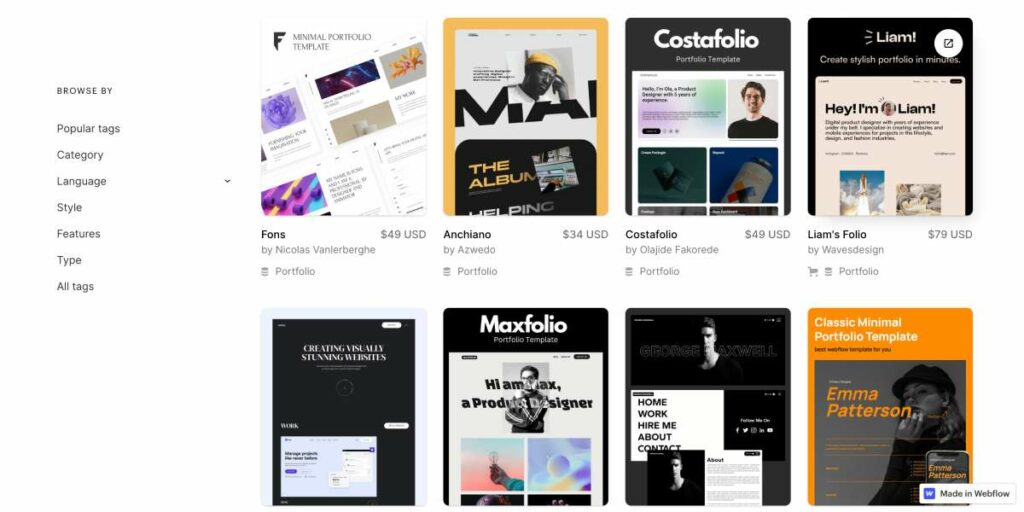
Who Should Use Webflow:
Webflow is an excellent choice for experienced creatives who want complete control over their portfolio website's design. It's particularly well-suited for designers and developers who want to take advantage of Webflow's advanced design features.
To maximize the benefits of this flexibility, working with a specialized Webflow agency can help bring your creative visions to life with professional expertise.
Read More: Webflow Review
2. Squarespace

- Minimal Templates
- User Friendly
- SEO
- Starting $16/month
Pros
- Excellent design capabilities
- Built-in SEO optimization
- Comprehensive analytics dashboard
Cons
- Limited customization options for some templates
- Relatively expensive compared to other website builders
Squarespace is a popular website builder with sleek and modern templates. It's known for its excellent design capabilities and built-in SEO tools. Squarespace offers a 14-day free trial, with paid plans starting at $16 per month.
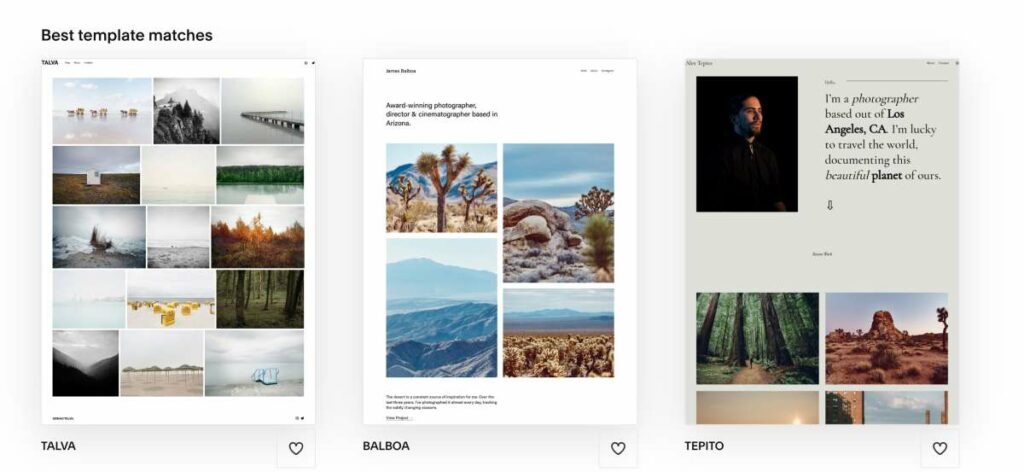
Who Should Use Squarespace:
Squarespace is an excellent choice for creatives who want a professional-looking website with built-in SEO optimization. It's particularly well-suited for photographers, artists, and designers who want a sleek and modern portfolio. Very easy to use even for beginners.
Read More: Webflow vs SquareSpace Review
3. Wix

- Easy To Use
- Cheap
- Starting free
- $14/month
Pros
- User-friendly interface
- Wide range of design options
- Affordable pricing
Cons
- Limited customization for free plan users
- No built-in blogging platform
Wix is a user-friendly website builder with a variety of templates and drag-and-drop tools for easy customization. It's an excellent choice for creatives who want a website without the hassle of coding. Wix offers a free plan with limited features, as well as paid plans starting at $14 per month.

Who Should Use Wix:
Wix is a great choice for creatives who want a simple and affordable website builder with a wide range of design options. It's particularly well-suited for those who don't have technical expertise or coding skills.
Read More: Wix Full Review
4. WordPress

- Customizable
- Scalability
- Integration
- Free
Pros
- Highly customizable
- Thousands of plugins and themes are available
- Free to use
Cons
- More complex than other website builders
- May require technical expertise
WordPress is an open-source content management system that powers over 40% of all websites on the internet. It's a highly customizable platform with thousands of plugins and portfolio WordPress themes available.
While WordPress can be more complex than other website builders, it offers unparalleled flexibility and customization options.
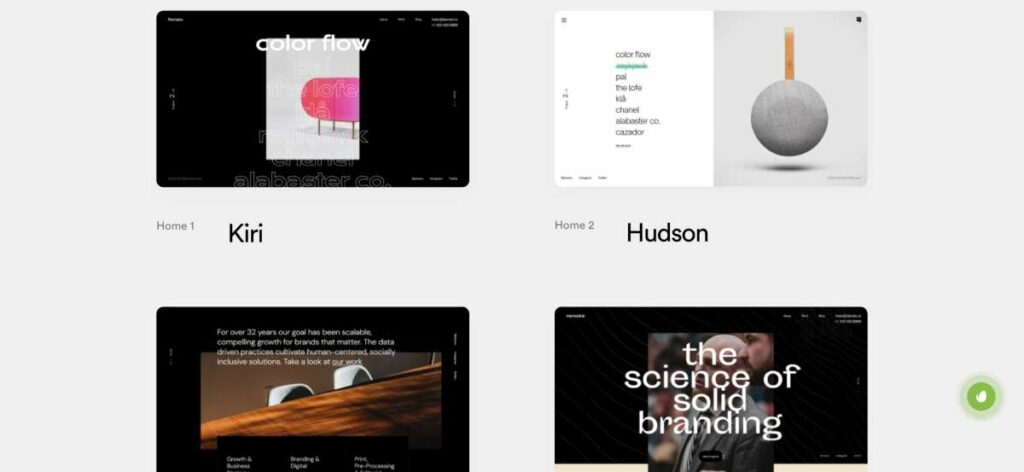
WordPress is free to use, but you'll need to purchase a domain name and web hosting.
Who Should Use WordPress:
WordPress is an excellent choice for creatives who want complete control over their website's design and functionality. It's particularly well-suited for those with technical expertise or the willingness to learn.
You can also check out our full guide on How to Create WordPress Portfolio Website in 2023
5. JIMDO

- User-friendly interface
- eCommerce functionality
- Starting from $9/month
Pros
- User-friendly interface
- Wide range of features, including eCommerce functionality
- Affordable pricing
Cons
- Limited customization options for some templates
- No built-in SEO optimization
Jimdo is a website builder that's great for beginners. It offers a drag-and-drop interface, customizable templates, and a wide range of features like a built-in blog and eCommerce functionality.
Jimdo offers a free plan with limited features, as well as paid plans starting at $9 per month.
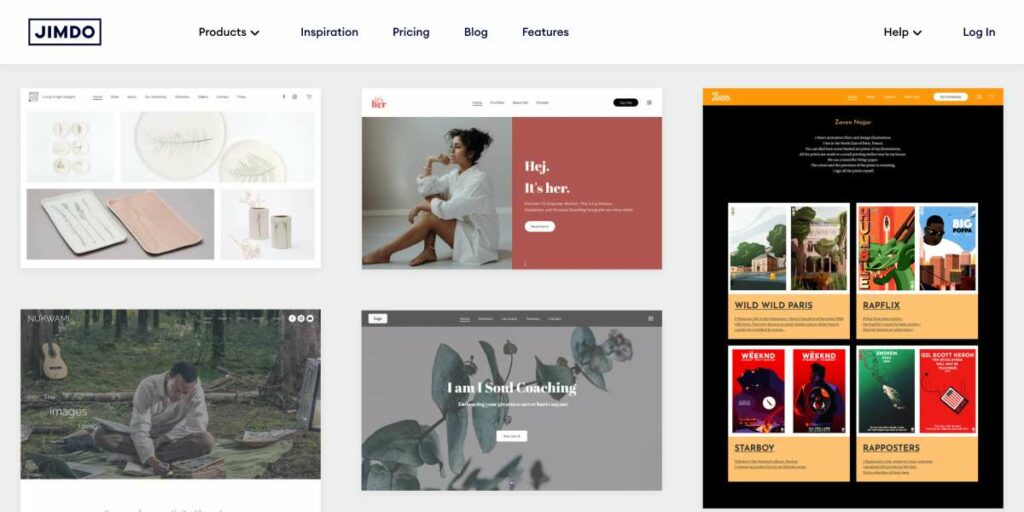
Who Should Use Jimdo:
Jimdo is an excellent choice for beginners who want a simple and affordable website builder with eCommerce. It's particularly well-suited for small businesses and online retailers who want to sell products through their websites.
6. Format

- Photographer Features
- Dedicated Portfolio Templates
- Free
- Starting from $15/month
Pros
- Designed specifically for creative professionals
- Wide range of features, including client proofing and image protection
- Built-in SEO optimization
Cons
- Relatively expensive compared to other website builders
- Limited design options for some templates
Format is a portfolio website builder specifically designed for photographers. It offers a range of customizable templates and features like client proofing, image protection, and built-in SEO optimization. Format offers a 14-day free trial, with paid plans starting at $15 per month.
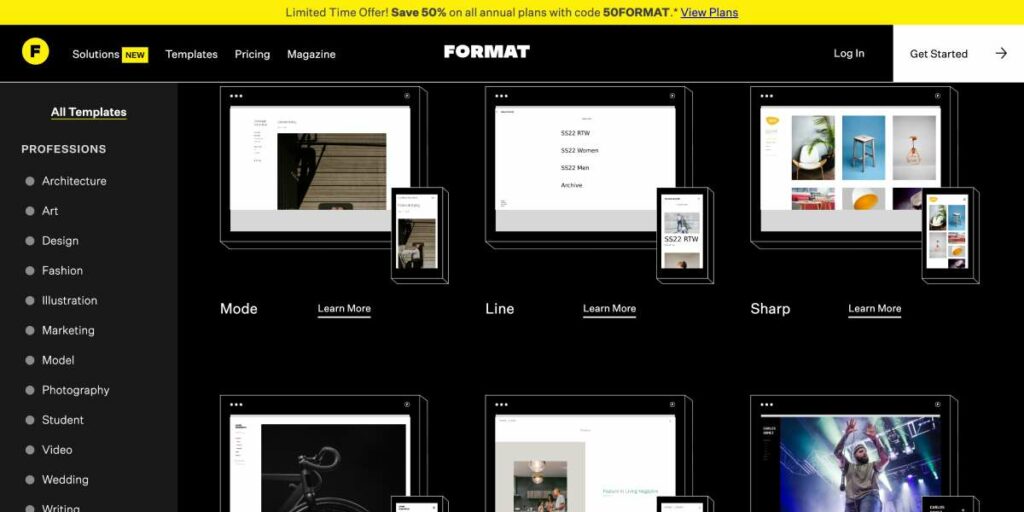
Who Should Use Format:
Format is an excellent choice for creative professionals who want a portfolio website builder that's tailored to their needs. It's particularly well-suited for photographers, artists, and designers who want a range of features to showcase their work.
7. Shopify

- eCommerce
- Customizability
- Integration
- Free 14 Days
- Starting from $29/month
Pros
- Built specifically for eCommerce functionality
- Wide range of features, including order management and built-in SEO optimization
- Customizable templates
Cons
- Relatively expensive compared to other website builders
- Limited design flexibility for some templates
Shopify is an eCommerce platform that also offers a website builder, making it an excellent choice for creatives who want to sell products through their portfolio website.
It offers a range of customizable templates and features like order management, built-in SEO optimization, and a mobile-responsive design. Shopify offers a 14-day free trial, with paid plans starting at $29 per month.
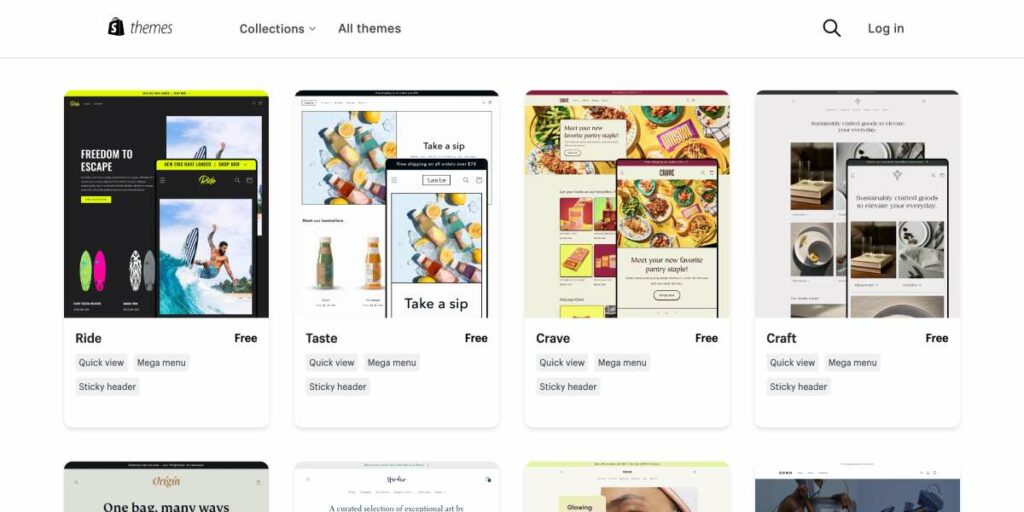
Who Should Use Shopify:
Shopify is an excellent choice for creatives who want to sell products through their portfolio website. It's particularly well-suited for online retailers who want to take advantage of Shopify's robust eCommerce functionality.
Comparison of Top Portfolio Website Builders
To help you make an informed decision, here's a comparison table of the top portfolio website builders we've discussed:
| Website Builder | Features | Pricing | Pros | Cons | Customer Reviews |
|---|---|---|---|---|---|
| Webflow | Advanced design flexibility, built-in SEO optimization, eCommerce functionality, mobile-responsive design | Free plan with limited features, paid plans starting at $16 per month | Advanced design flexibility, wide range of features | Steep learning curve for beginners, relatively expensive compared to other website builders | 4.4/5 |
| Squarespace | Sleek and modern templates, built-in SEO optimization, eCommerce functionality, mobile-responsive design | 14-day free trial, paid plans starting at $16 per month | Visually appealing templates, built-in SEO optimization | Relatively expensive compared to other website builders, limited design flexibility | 4.4/5 |
| Wix | User-friendly interface, eCommerce functionality, mobile-responsive design | Free plan with limited features, paid plans starting at $14 per month | Affordable pricing, wide range of features | Limited customization options for some templates, no built-in blog functionality | 4.2/5 |
| WordPress | Open-source platform, extensive customization options, mobile-responsive design | Free to download and use, paid plans for web hosting starting at $4 per month | Extensive customization options, open-source platform | Steep learning curve for beginners, requires web hosting and domain name registration | 4.4/5 |
| JIMDO | User-friendly interface, mobile-responsive design, eCommerce functionality | Free plan with limited features, paid plans starting at $9 per month | Affordable pricing, user-friendly interface | Limited design flexibility, limited customization options for some templates | 4.0/5 |
| Format | Sleek and modern templates, built-in SEO optimization, mobile-responsive design | 14-day free trial, paid plans starting at $15 per month | Visually appealing templates, built-in SEO optimization | Limited customization options, no built-in blog functionality | 4.4/5 |
| Shopify | eCommerce functionality, order management, built-in SEO optimization, mobile-responsive design | 14-day free trial, paid plans starting at $29 per month | Built specifically for eCommerce functionality, wide range of features | Relatively expensive compared to other website builders, limited design flexibility for some templates | 4.4/5 |
Discussion of comparison results
All of the website builders we've discussed have their strengths and weaknesses. Wix is an excellent choice for beginners who want a simple and affordable website builder with a wide range of features.
Squarespace is best suited for creatives who want a visually appealing portfolio website without the need for extensive customization.
Shopify is an excellent choice for creatives who want to sell products through their portfolio website, while
Webflow is ideal for experienced creatives who want complete control over their portfolio website's design.
When it comes to pricing, Wix and Squarespace offer more affordable options compared to Shopify and Webflow. However, Shopify and Webflow offer more advanced features, including eCommerce functionality and advanced design flexibility.
Recommendation based on comparison results
Based on our comparison, we recommend Webflow as the best portfolio website builder. While it has a steeper learning curve for beginners, it offers the most advanced design flexibility, which is essential for creatives who want complete control over their portfolio website's design.
It also offers a wide range of features, including eCommerce functionality and built-in SEO optimization, making it a versatile option for both artists and online retailers.
However, if you're a beginner looking for a more affordable option, Wix is an excellent choice. Squarespace is ideal if you want a visually appealing portfolio website without the need for extensive customization, while Shopify is perfect if you want to sell products through your portfolio website. Ultimately, the best portfolio website builder depends on your specific needs and preferences.
Criteria for Selecting the Best Portfolio Website Builder
Before diving into our top picks, let's review the key criteria we used to evaluate portfolio website builders:
Ease of Use: A portfolio website builder should be easy to use and navigate, even for those with little to no technical expertise.
Design Flexibility: A good portfolio website builder should provide a wide range of design options, including customizable templates and the ability to add custom CSS.
Pricing: We considered the cost of the portfolio website builder, including any additional fees for hosting, domain registration, and premium features.
SEO Optimization: We evaluated each portfolio website builder's search engine optimization (SEO) features to ensure that your website is easily discoverable by potential clients. You can also check: 7 Best Website Builders for SEO (Compared)
Customer Support: Finally, we looked at the level of customer support provided by each portfolio website builder, including resources like tutorials, help articles, and customer service channels.
You might be interested in reading: The Best No-Code Website Builders: Top 13 Ranked
Conclusion
Choosing the right portfolio website builder can be challenging, but it's an essential step in establishing your online presence as a creative professional. By considering factors like ease of use, design flexibility, pricing, SEO optimization, and customer support, you can find the best portfolio website builder for your needs.
Whether you choose Wix, Squarespace, Shopify, or Webflow, each of these website builders offers unique features and benefits to help you create a stunning portfolio website.
Ludjon, who co-founded Codeless, possesses a deep passion for technology and the web. With over a decade of experience in constructing websites and developing widely-used WordPress themes, Ludjon has established himself as an accomplished expert in the field.



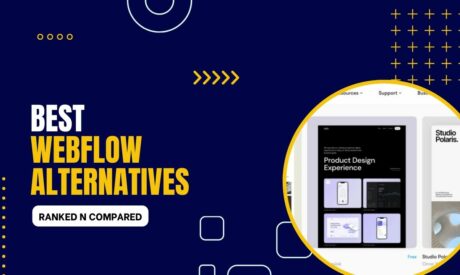


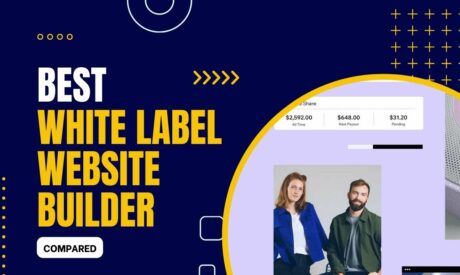


Comments